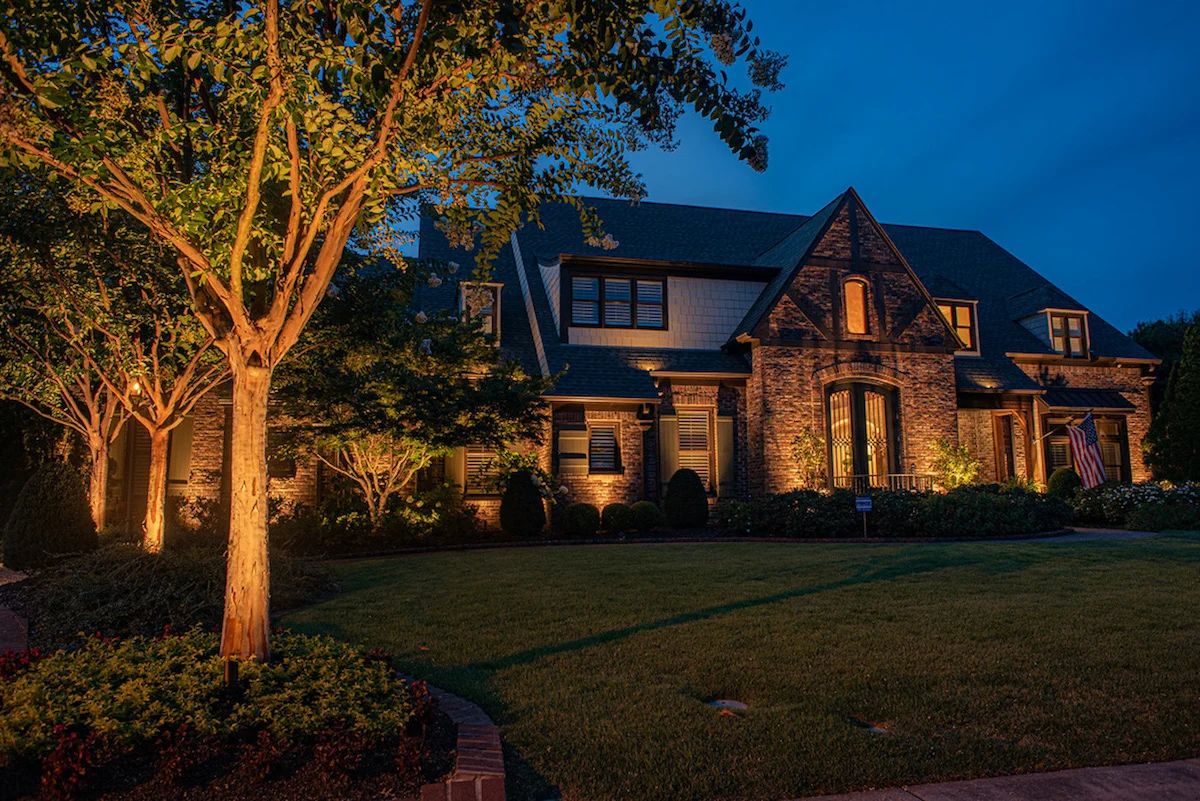Tree Uplighting, the art of illuminating trees, is a game-changer in modern landscape design. It doesn’t just light up gardens—it transforms them into captivating landscapes after the sun sets. Outdoor tree lighting enhances aesthetics, creates mesmerizing atmospheres, and adds substantial value to your property. In this article, we will explore the fundamentals of Tree Uplighting, offer practical guidance, and ignite your creativity with design ideas. Gardenreet Lighting is a distinguished brand celebrated for its exquisite brass landscape lighting. You may find the right outdoor lighting solution for you here.

Core Elements of Tree Uplighting
Let’s explore the essential components of landscape tree lighting: the light source, wattage, beam angle, and installation position. These factors are pivotal in crafting an enchanting nocturnal garden.
Choosing the Right Light Source: A Range of Options
Tree Uplighting offers a plethora of light source choices, each with its own distinct characteristics suited to various scenarios and effects. Here’s a breakdown of the differences between these light sources:
LED Fixtures: LEDs are renowned for their energy efficiency and longevity. They come in various color temperatures and brightness levels, offering flexibility to cater to different lighting needs.
Halogen Bulbs: Halogen bulbs emit a warm, welcoming light that accentuates the natural beauty of trees. However, they consume more energy and have a relatively shorter lifespan.
Solar Uplighting For Trees: Solar-powered fixtures are an eco-friendly choice, powered by sunlight during the day. They are suitable for energy-efficient illumination but may have limited intensity.
Wattage: Tailoring Light to Tree Size
Different tree types and sizes necessitate varying wattages to accentuate their unique attributes. Here are guidelines for different tree sizes:
Small Trees: For shorter and narrower small trees, you typically can opt for LED bulbs in the range of 2 to 4 watts, with an approximate brightness of 250 to 350 lumens. This is sufficient to create a soft and enchanting illumination on the tree canopy and leaves.
Medium-Width Trees: For trees of moderate height but with broader canopies, you may require more light to cover the wider canopy effectively. Generally, selecting LED bulbs in the range of 4 to 10 watts, with an output of approximately 350 to 1000 lumens, can provide brighter illumination.
Large and Broad Trees: Tall and wide-spreading trees demand more powerful lighting. Opt for LED bulbs with a wattage of 10 watts or higher, typically yielding 1000 lumens or more, to ensure even coverage across the entire canopy.
Beam Angle: Directing Light with Precision
The beam angle plays a crucial role in Tree Uplighting. It determines how wide or narrow the light beam spreads. For different tree types and desired effects:
Narrow Beam Angle (25-35 degrees): Suitable for small and narrow trees, this angle concentrates light on the canopy, creating a focused and intimate ambiance.
Medium Beam Angle (35-50 degrees): Ideal for medium-width trees, it provides balanced illumination across the canopy, highlighting their beauty.
Wide Beam Angle (50-120 degrees): Perfect for large and broad trees, this angle ensures comprehensive canopy coverage, enhancing their grandeur.
Installation Position: Tailored to Tree Size
Consider the installation position based on the tree’s height and width:
Small and Narrow Trees: Install fixtures closer to the base of the tree to accentuate its vertical height and create an enchanting upward glow.
Medium-Width Trees: Position fixtures both near the base and strategically around the canopy to evenly illuminate the tree, highlighting its grace.
Large and Broad Trees: Install multiple fixtures around the tree’s base or along its periphery to ensure complete coverage, revealing the tree’s majestic presence.
Understanding the array of available light sources, specifying suitable wattages, choosing the right beam angle, and strategically positioning your fixtures tailored to tree size empowers you to craft a truly enchanting nighttime garden.
Selecting Suitable Trees for Garden Tree Uplighting
In this section, we’ll explore the criteria and considerations for tree selection, along with specific tree recommendations commonly found in American gardens.
Considerations for Tree Selection
Tree Size and Shape: When selecting trees for Uplighting, consider the size and shape of the trees. Some tree species, such as Maples, Oaks, and Pines, are common choices due to their elegant forms and beautiful foliage.
Foliage Characteristics: Trees with unique foliage characteristics, like Dogwoods with their colorful flowers or Elms with their graceful canopy, can be effectively highlighted with Uplighting.
Seasonal Changes: Think about how the tree’s appearance changes throughout the seasons. Many American trees, such as Maples and Pines, are known for their stunning autumn foliage.
Landscape Impact: Evaluate the tree’s location in your garden and its compatibility with the overall landscape design. Trees like Cedars and Cypress are often used to enhance garden aesthetics.
Tree Selection Guidelines
Small Trees: For small gardens, consider options like Dogwoods or smaller Maples, such as the Japanese Maple, known for their compact size and captivating appearance.
Medium Trees: Medium-sized trees like Oaks and Pines offer a balanced choice. Their size allows for an impactful Uplighting display while fitting well within most garden layouts.
Large Trees: Majestic, large trees such as Oaks and Cedars benefit from robust Uplighting solutions, emphasizing their grandeur.
Selecting the right trees for Tree Uplighting not only enhances the beauty of your garden but also contributes to an inviting nighttime ambiance.
Choosing the Right Fixtures
In this section, we’ll explore various fixture options and provide design inspiration and tips to enhance the visual impact of your tree uplighting project.
Spotlights: Spotlights are a popular choice for tree uplighting due to their ability to focus light precisely where it’s needed. Use adjustable spotlights to highlight specific features of a tree, such as its trunk, branches, or foliage. Experiment with fixture placement to create captivating shadows on nearby surfaces, adding depth and intrigue to your garden’s nighttime ambiance.
Well Lights: Well lights are installed flush with the ground and provide uplighting from below. They can be discreetly positioned around the base of a tree to create a dramatic upward lighting effect. Consider using warmer color temperatures (around 2700K to 3000K) for a cozy and inviting atmosphere.
Down Light: Some fixtures are specially designed for tree uplighting or downlighting, featuring adjustable brackets or arms that can be attached directly to the tree trunk or branches. These fixtures provide flexibility in directing light at various angles. Create a moonlighting effect by placing fixtures high in the branches, casting gentle, dappled light through the leaves and branches.
Floodlights: Floodlights emit a wide beam of light and are suitable for illuminating larger trees. They are often used when a broad, even illumination is desired.
Choosing the right fixtures for tree uplighting is a creative endeavor that allows you to sculpt the nighttime beauty of your garden. Whether you prefer subtle accents or dramatic effects, thoughtful fixture selection and placement, combined with design inspiration and tips, can transform your trees into captivating focal points of your landscape.
Additional Tips
In addition to the key elements and design inspiration mentioned above, here are some additional factors to consider in tree uplighting projects:
Environmental Considerations: When selecting lighting fixtures and light sources, consider choosing energy-efficient LED lighting to reduce energy consumption and carbon footprint. Additionally, timers and photocells can help conserve energy by ensuring that the lighting is only activated when needed.
Regulatory Compliance: Before installing tree uplighting, familiarize yourself with local building regulations and light pollution ordinances. Ensure that your project complies with all applicable regulations and requirements to avoid potential legal issues.
Maintenance and Care: Regularly inspect and maintain your tree uplighting system, including cleaning fixtures and checking wiring connections. Replace damaged components promptly to ensure the proper functioning of the system.
Professional Assistance: For complex tree uplighting projects, especially those involving large trees or electrical work, it is advisable to seek professional assistance. Professional designers and installation teams can ensure the successful implementation of the project.
These additional tips will help ensure the smooth execution of your tree uplighting project while minimizing adverse effects on the environment and regulatory compliance, ensuring that your outdoor space continues to radiate beauty and warmth at night.
FAQs
What is the best way to uplight a tree?
The best way is to use adjustable spotlights or tree-mounted fixtures to illuminate the tree’s canopy and trunk effectively.
How many lumens do I need to uplight a tree?
The lumens required vary with tree size and desired effects. Small trees generally need about 300 lumens (such as a small 3-foot tree), medium-sized trees need 500 lumens (such as palm tree landscape lighting), and large trees may need 1,000 lumens or more (such as a cedar).
Is Uplighting better than Downlighting?
The choice depends on your design goals. Uplighting accentuates the tree’s features, while downlighting provides more even illumination for the surrounding area.
What is the best wattage for uplighting trees?
Wattage depends on tree size. Small trees usually require 2-4 watt LED bulbs, medium-sized trees 4-10 watts, and large trees 10 watts or more (LED).

